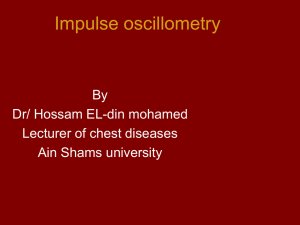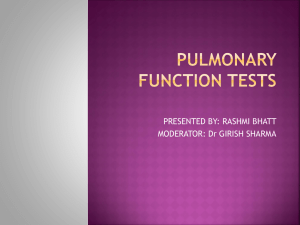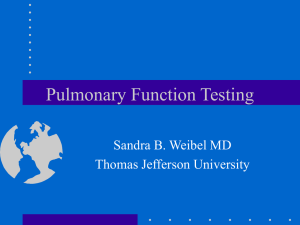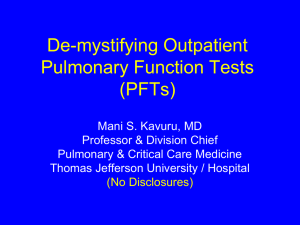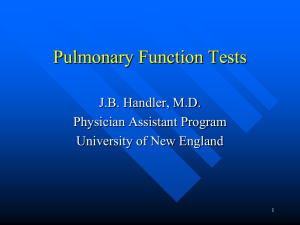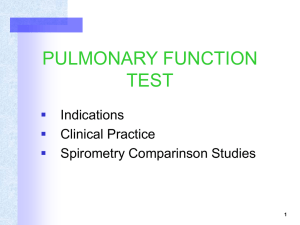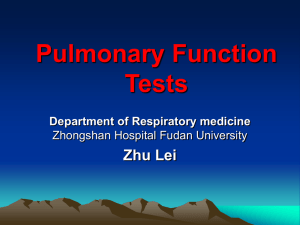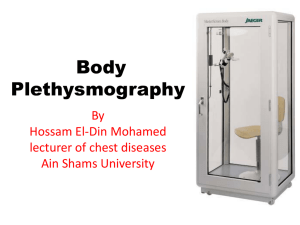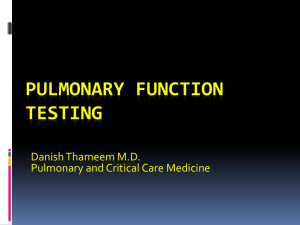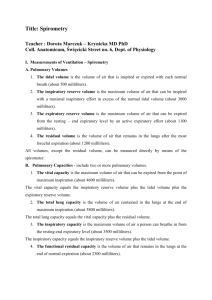Pulmonary Function Tests
advertisement
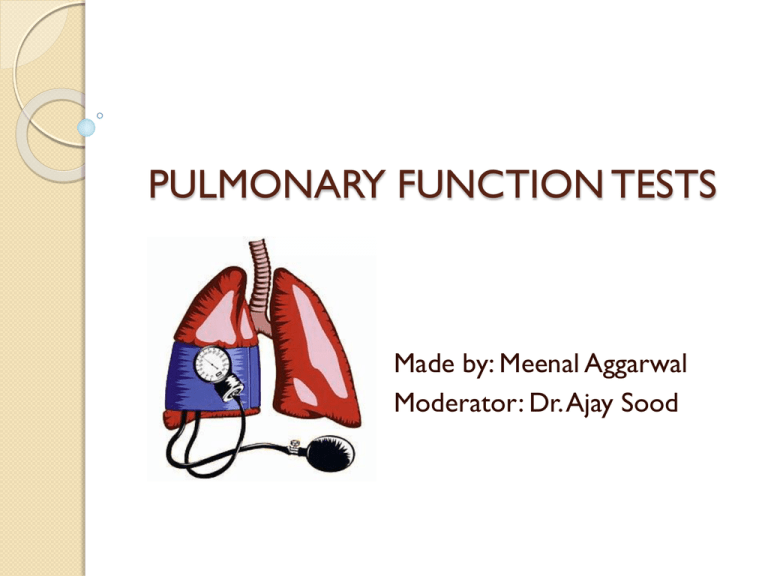
PULMONARY FUNCTION TESTS Made by: Meenal Aggarwal Moderator: Dr. Ajay Sood Lung Volumes & Capacities ◊ Respiratory minute volume (at rest): 6 L/min ◊ Alveolar ventilation (at rest): 4.2L/min ◊ Maximum voluntary ventilation: 125-170 L/min Pulmonary Function Tests : Introduction Aim: to identify abnormal lung function in hope of altering patient’s outcome by reducing risk of intra/post op ventilatory impairments Enables us to: ◦ Assess the presence and severity of respiratory dysfunction ◦ Follow the progression of impairment ◦ Document the response to therapy 2 major groups of tests: ◦ To detect abnormalities of gas exchange ◦ To assess mechanical ventilatory functions of lungs & chest wall Clinical Spirometry Inventor: John Hutchinson Vital Capacity: The largest volume measured after the subject inspires deeply and maximally to TLC and then exhales completely to RV Normal values are lower in supine than in sitting Abnormal: when <80% seen in restrictive ds: • Lung pathologies (pneumonia, atelectasis, pulmn fibrosis) • Loss of lung tissue (Following surgical resection) • Diminished effort (muscle paralysis, abdominal swelling, ) Time Expired Spirogram After a maximal inspiratory effort subject exhales as forcefully and rapidly as possible Forced Vital Capacity: Exhaled volume if recorded with respect to time Reflects flow resistive properties of the airways Practice attempts given, 3 acceptable tracings required Normal: Exhalation takes at least 4 sec, should not be interrupted by coughing, glottic closure or any mechanical obstruction FEV1 (Forced Expiratory volume in 1sec): Either in Lt or FEV1/FVC percentage Normal: 75-80 % Abnormal: Mild obst <70% Moderate obst <60% Severe obst <50% Restrictive diseases: dec TLC, dec FVC, so dec FEV1 but ratio FEV1/FVC either normal or increased Disease state FVC (L) FEV1 (L) FEV 1/FVC (%) Airway obstruction (asthma, chronic bronchitis) N Dec Dec Stiff lung (pneumonia, pulmonary edema, pulmonary fibrosis) Dec Dec N Resp muscle weakness (MG, myopathies) Dec Dec N PEFR: (Peak Expiratory Flow Rate) Maximum flow rate obtainable at any time during FVC maneuver L/sec or L/min Usually measured as the average flow of gas expired after initial 200ml (k/a FEF 200-1200 or MEFR) Can be measured with a handheld flow meter (serves as a bed side test) or a pneumotachygraph Markedly affected by obstruction of large airways Responsive to bronchodilator therapy so used to monitor therapeutic response in acute asthma N value: 500Lts/min or more If < 200Lts/min, suggests impaired cough efficiency and likelihood of post op complications Also affected in muscle weakness Variable as highly dependent on patient effort FEF25-75%: (a/k/a Forced Mid-Expiratory Flow) Middle half of FVC doesn’t require high degree of efforts k/a Effort independent (not truly as marked reductions in effort will reduce it) Negative effort dependence: flow rates can actually decrease with truly maximum efforts compared from a slightly submaximal effort (d/t dynamic airway compression) N value: 4.5 – 5 L/sec Sensitive indicator of early obstruction in small distal airways Reduced even in restrictive ds, but FEV1/FVC is Normal Maximum Breathing Capacity: a/k/a MVV (Maximum Voluntary Ventilation) Largest volume that can be breathed per minute by voluntary effort Instructed to breathe as hard and fast as possible for 12 sec, and then extrapolated to 1min Reduced in obstructive diseases Other factors: elasticity of lungs, resp muscle strength, patient co-operation Correlates well with FEV1 (MVV= FEV1 X 35) Normal: 150-175L/min < 80% indicates gross impairment in resp function Respiratory Muscle Strength: All Above parameters are affected by muscle strength Evaluated by maximum static respiratory pressures (pressures generated against an occluded airway during a maximal forced inspiratory or expiratory effort) Measured with Aneroid gauges (at FRC, to nullify effect of elastic recoil) PImax (near RV) : -125cm H2O If < -25 cm H2O, severe inability to take a deep breath PEmax (near TLC) : +200 cm H2O If < +40 cm H2O, severely impaired coughing ability Useful in evaluating patients with Neuromuscular disorders Gauge Methods for Measuring Residual Volume • Body plethysmography • Helium dilution method Physiological Determinant of Maximum Flow Rates 3 factors: • Degree of effort (PEmax: at TLC, PImax: at RV) • Elastic recoil pressure of lungs (PL): Max at TLC: 25-30cm H2O Min at RV: 2-3 cm H2O Is opposed by elastic recoil of chest wall (Pcw) Net recoil Prs: PL + Pcw (zero at FRC) • Resistance to flow provided by airways (Raw): determined by size of airway, so min at TLC, max at RV Gaw (conductance, 1/ Raw, is related to lung volume linearly) Flow – Volume Relationships: Useful as all determinants of flow are dependant on volume • During FVC, flow rises to a max at a volume close to TLC • Gradually: • Lung volume decreases Airways become narrower Resistance increases Flow rates decrease In Obstructive ds, flows are decreased over full range Airway Compression & Flow Limitation: Value in coughing Sites & Mechanisms of Decreased Airflow in Diseases: D/t alterations in any 3 of the parameters (PEmax, PL, Raw) Disease PEmax Raw PL Neuromuscular weakness Dec N N Emphysema N N Dec Asthma, Bronchitis N Inc N Peripheral Airway Disease N N N Measurement of Airway Obstruction Airway Resistance: (Raw) • • • • • • Technique: patient pants once or twice per second through a mouth piece with a nose clip in place (to bypass max resistive areas-nose, nasopharynx) Also panting maneuver keeps larynx dilated Subject sits in a constant volume body plethysmograph (body box) Lung volume & Raw can be measured using changes in the box pressure and volume (using Boyle’s law) Normal Raw: 2cm H2O L/sec Head flexion causes increased Raw (measured) as it reduces the caliber of hypopharynx, so be as errect as possible during maneuver Forced Expiratory Maneuvers (FVC, FEV1, PEFR): • Tells whether obstruction is present Flow-Volume loops: Allows to discriminate b/w upper airway obstructive lesions • Subject inhales fully to TLC and then performs FVC maneuver, followed immediately by a max inspiration as quickly as possible to TLC • Whole inspiration and expiration near TLC are effort dependent (Normal = 1.0) • Mid VC ratio: ratio of expiratory flow to inspiratory flow at 50% VC • • • • • • • Help to localize site & nature of obstruction Upper airway obstruction: inspiratory flow reduced more than expiratory, so mid VC ratio >1 Fixed airway obst : both inspiration and expiration reduced to same extent so plateaus of constant flow, so ratio = 1 Variable obstruction: Lesion whose influence varies with the phase of respiration Extrathoracic: l/t increased obst during forced inspiration, mid VC ratio >2 Intrathoracic: Increased obstruction during forced inspiration, mid VC ratio is low Tests of Early Lung Dysfunction Small airway disease, minimal airway dysfunction, early obstructive lung disease It is a fore runner of chronic bronchitis & emphysema Alveolar –Arterial Oxygen Tension Difference: Detects regional V/Q mismatch PaO2 =measured easily PAO2 = PiO2 – PaCO2 / R Difference : PAO2- PaO2 Normal value at room air: 8 mm Hg Increases with age (occurs d/t dec PaO2) Frequency Dependence of Compliance: In normal lung: compliance not dependent on respiratory frequency In small airway obstruction, d/t asynchronous behaviour of lung units where some areas of lung are moving out of phase with others, the compliance decreases with a high respiratory rate If it falls to <80% : k/a compliance to be frequency dependent Multiple- Breath Nitrogen Washout: Mild obstructive airway disease leads to uneven distribution of ventilation, measured by SBNW Normal : lung behaves as a single compartment and produces a fast single exponential curve for N2 wash out Abnormal : Lung appears to have more than one ventilatory compartment (d/t uneven dist of ventilation) So different units have their N2 diluted at different rates, and so producing a tail on the washout curve Very sensitive test, but requires computerization for analysis of curve Single Breath N2 Washout: Described by Fowler in 1949 Expired N2 conc was measured after inspiration of 1 L of O2 from FRC The change in N2 concentration b/w 750-1250 ml of expired volume in seen Modified method: Instead of just 1 L, patient makes a full inspiratory effort in 100% O2. the alveolar nitrogen slope with this method is less steep (as now whole lung is filled with O2, c/f 1L in which only lung bases are filled leading to an inc Apex base difference, so steeper slope) The slope of alveolar nitrogen plateau is larger in old subjects (reflecting uneven evntilation) <2% normal, Even Upto 10% in smokers Closing Volume: Lung volume at which the airways in the dependent areas in the lungs begin to close Occurs because lower portions of lungs are subject to Ppl pressure in excess of airway pressure, l/t closure of airways Technique: tagging of these lung areas by giving them a different concentration of a tracer gas c.f. apex. 2 methods: Bolus gas (uses He) Resident gas (uses N2) First a gradient is created, and then expiratory levels of gas are plotted. The volume at which phase 3 begins is known as closing volume Closing capacity = closing volume + RV Increases with age, in smokers Bed-Side PFT’s 1. Snider’s Match Blowing Test: Mouth wide open Match held at 15 cm distance Chin supported No head tilting Match stick & mouth at same level Cannot blow out a match: MBC < 60 L/min FEV1 <1.6 L * Modified Snider’s test: 3 inches: MBC >40 L/min 6 inches: MBC >60L/min 9 inches: MBC >150 L/min 2. Forced Expiratory Time: FET < 3 sec (restrictive disease) FET > 6 sec (obstructive disease) 3. Seberese’s Single Breath Count: Patient is asked to take a deep breath followed by counting, till the time he cannot hold breath Shows trends of deteriorating/ improving lung functions 4. Seberese’s Breath Holding Time: Subject is asked to N tidal inspiration & hold breath • Normal >= 40 sec • < 15 sec C/I for surgery • 5. Cough test: Observe for ability to cough (strength & effectiveness) Wet productive cough = prone for pulm complications Inadequate cough= FVC < 20 ml/kg, FEV1 < 15ml/kg 6. De Bono’s Whistle Test: Wide bore tube with a whistle at end and an adjustable leak hole at the side, whistle blows only when air flow exceeds a certain value 7. Wright’s Peak Flow Meter: Normal males: 450- 700 l/min Females: 300-500 l/min Values< 200 l/min suggests impaired cough efficiency Peak flow meter Indications for PFT in Surgical Patients: Patient factors: • Known Chronic pulmonary disease • Heavy smoker (>1 pack/day) • Chronic productive cough • Recent respiratory infections • Advanced age (>70 yrs) • Obesity (>30% over ideal wt) • Thoracic cage deformity (kyphoscoliosis) • Neuromuscular disease (MG) Procedure: • Thoracic or upper abdominal surgery • Pulmonary resection • Prolonged anesthesia Pre-op Measures to Improve Lung Function: Goal: to reduce intra/post op pulmonary complications 4 basic modalities: • Smoking cessation: after 2-4 wk (reduced secretions, airway reactivity & improved mucociliary clearance) • Treatment of bronchospasm (Beta 2 agonists, antichol, theophylline) • Removal of secretions (AB therapy, adequate hydration, mucolytics, postural drainage, chest percussions) • Motivation & Stamina (incentive spirometry) Thank You
